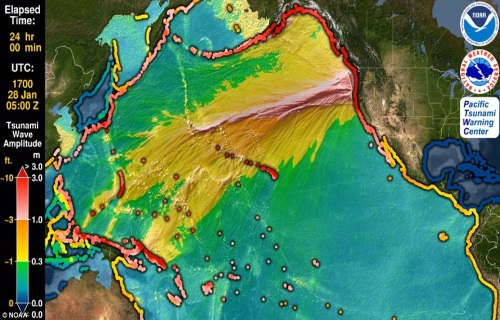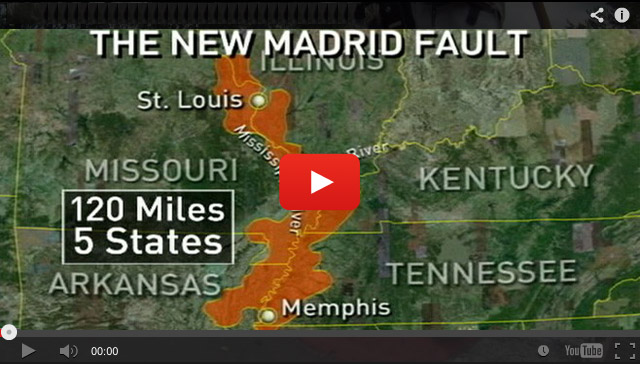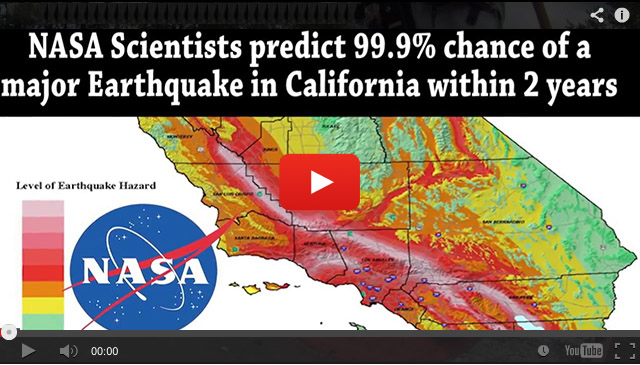California is the land of beaches, mountains, and all the legal marijuana you can stomach. It’s also, inconveniently, a dangerous minefield riddled with nasty fault lines that rupture without much warning, generating massive earthquakes that can level buildings, pulverize roads, and kill lots of people in the span of seconds.
The San Andreas is the most notorious of these faults. It runs roughly 800 miles long and produces quakes so catastrophic that there’s a 2015 action movie about it starring The Rock. The southern section of the fault generates earthquakes every 150 years on average, and considering some parts of it haven’t ruptured in more than 200 years, Southern California is overdue for a major shaking, otherwise known as “the Big One.”
“There is no fault that is more likely to break [in California] than the San Andreas Fault,” says Michio Kaku. “Small local earthquakes—the Northridge earthquake, the San Fernando earthquake—they can kill people in the dozens, they can have freeways coming down, they can affect dams, and all of that is bad,” he says. “But it doesn’t really pose an existential threat to our economy, our ability to live here.” A large earthquake on the San Andreas Fault, on the other hand, he says, could create a devastating threat to humanity, infrastructure, and the economy, with implications that extend nationally and even globally.
Scientists don’t know exactly where the Big One will hit or how large it will be when it does, but they do have some ideas: One of the most likely scenarios, according to a 2008 federal study, is a 7.8 magnitude earthquake starting at the Salton Sea and running up through Lake Hughes, on a 200 mile long section of the fault that, in parts, hasn’t ruptured since 1680—almost two centuries before California became part of the United States and long before it had any major infrastructure.
The largest possible earthquake that can strike throughout most of the San Andreas is an 8.4 magnitude, according to Southern California Earthquake Center spokesperson Mark Benthien, who says the bigger the earthquake, the lower the probability of it striking. While the impact depends on a range of unknowable factors, here’s what experts say might happen in the moments, hours, and days immediately after the big one rattles California.
The death toll probably won’t be as bad as movies like San Andreas—which Benthien calls “Hollywood fantasy”—make it out to be. Scientists predict that a magnitude 7.8 earthquake along the southern San Andreas would likely kill about 2,000 people—or less than .1 percent of Southern California’s population of more than 22 million.
Luckily, the San Andreas fault is far enough inland that its rupture wouldn’t disrupt the ocean floor and cause a tsunami, according to Benthien. He says the biggest threat of a tsunami comes from smaller faults off the coast, particularly in far northern California, where the Cascadia subduction zone begins in Cape Mendocino and stretches about 500 miles north to Vancouver.
Computer Simulation of an Earthquake | California Academy of Sciences
The California Earthquake Authority (CEA) wants to help more Californians prepare to survive and recover from the next damaging earthquake during the annual Great California ShakeOut.
Power Lines Collapse
“The first thing [to fail] is usually electricity. It’s usually almost instantaneous,” says Brad Aagaard, a research geophysicist at the United States Geological Survey’s Earthquake Science Center. It doesn’t take an enormous earthquake for that to happen: A magnitude 6 would do the trick, Aagaard says.
The degree of damage depends on how many electric power transmission lines intersect with the part of the fault that ruptures. The southernmost section of the San Andreas fault, for example, crosses more than 140 different transmission lines, according to the 2008 analysis. “There’s a lot of electricity lines crossing. If it’s crossing from one tower to the next tower and the towers don’t collapse, you can have the fault moving underneath and it’s probably alright,” says Stewart. “Of course, if the towers do collapse, then you’re going to have some issues.” Those issues might include wildfires, which could erupt as a result of damage to the power lines. (Because most major transmission towers are in remote areas, they wouldn’t pose a huge risk of harm to people if they fell down, says Stewart.)
A suggestion: Stock up on flashlights, keep your phone and laptop charged, and hoard some extra batteries, because you may be forced to reenact pioneer days if the power lines are downed. Stuffing a wad of cash under your mattress could be a good idea, too, since banks, ATMs, and credit cards might not work for a couple of days.
So for those of you who are looking to have a biogas generator to generate your own power, what if you could build a biogas generator for less than a hundred dollars? In fact, much less than you think? Because many times, we assume that it would be expensive to build a biogas generator for our own home use.
Oil and Gas Pipelines Rupture
If you think dealing with a dead iPhone and navigating your apartment—which may or may not still be standing—by candlelight is rough, wait until high-pressure gas lines rupture. When they break, they leak gas into the air, which can potentially ignite and cause explosions. The myriad natural gas and petroleum pipelines running through the Cajon Pass, a mountain pass between Los Angeles and Las Vegas, are particularly vulnerable to damage, says Benthien. The area not only lies on top of the San Andreas Fault, but it was actually formed by previous fractures in it.
Similar to power lines, the extent of the damage would depend on how many major gas and oil lines cross the fault when it moves. For some perspective: The southernmost section of the San Andreas fault alone intersects with 39 pipelines. One thing you can do to prepare, says Stewart, is to make sure you have access to an automatic shut off valve on the gas line running through your home. If you live in an apartment, ask your landlord if you have access to it.
Water and Sewer Pipes Fail
The Los Angeles Aqueduct, the Colorado Aqueduct, and the California Aqueduct are just some of the major networks that pump water into Southern California from the northern and eastern parts of the state. They also all cross the San Andreas Fault and could be catastrophically ruptured in a large-scale earthquake. “We would have to make do without all that imported water,” says Stewart. “It would be a race against the clock. Can we get these aqueducts repaired in time before we run out of our local water supply?”
Even if the aqueducts don’t break, a major earthquake would probably damage the water pipes, which presents a whole other set of problems: “How do you actually get the water from where it’s stored once it comes out of these aqueducts to people’s houses and businesses?” says Stewart. “This is going to be one of the biggest impacts actually. You’re going to turn on your tap, you’re not going to be able to use it.” Even if the water does come out of the tap, Stewart warns, it could potentially be contaminated from broken sewer lines, so the utility companies would have to issue warnings not to use it.
Part of the problem is that “many of the pipelines of Southern California have been in the ground for [up to] 100 years, and so they’re vulnerable, they’re breaking,” says Benthien. “You hear about water main breaks, you see it on the news. Those happen even when there’s not rumbling and shaking.” One piece of expert advice: Keep at least a two-week supply of water in your house so you won’t have to fight your neighbors over bottled water when the shit hits the fan.
Immediate Aftermath of the Quake
Communication Breaks Down
Living without Internet, phone service, and social media sounds anxiety-inducing enough as it is, but it could be a scary reality after the big one hits. “For many people, if they can’t go on Facebook or Twitter or Instagram, it may be more troublesome than if they don’t have water,” says Benthien. He’s thinking about instances where people might get trapped under rubble or separated from their friends and family and don’t have phone service or Internet to call for help or ask for resources.
It may sound counterintuitive, but if you do have cell service immediately after an earthquake, Benthien warns, don’t use it to make a phone call. He recommends sending a text instead, which uses up a fraction of the bandwidth on the cell network. “The phone system is not designed for everybody to be able to pick up their phone and make calls at the same time,” he says. That can lead to outages. If you really have to make a call, dial someone out of state and let them know you’re okay (or not) so you’re not jamming up the local phone lines.
Longterm Effects
Businesses Shut Down and the Economy Tanks
California boasts one of the largest economies in the world—but that may not be the case after the big one hits. Major transportation networks like railroads and highways could be shut down for days, weeks, or even months. Maybe the most detrimental shutdown would be the ports of Los Angeles and Long Beach, which handle about a quarter of all cargo entering the US. “The whole country is going to be impacted,” says Benthien, who adds that a lot of major retailers stock their stores around the country with inventory that arrives on ships docked at these major West Coast ports. Because most of the inventory is based on demand, if these ports closed, even for a couple of days, plenty of big box stores like Target and Walmart could have empty shelves for a while, even in areas that weren’t hit by an earthquake. (Consider that further motivation to stock up on water and other essentials now.)
“If you can’t unload the ships and get the stuff off the ships, then it won’t go through the stores,” says Benthien.
Not only that, but plenty of people could be out of work because their companies are forced to shut down, at least temporarily, due to power and water outages or building damage. “All these places that need water to do their business, they can no longer operate, they can no longer pay their employees,” Benthien says. Even someone whose employer isn’t impacted might not be able to get to work anyway: The highway they use to get to work might be fractured, their home could be uninhabitable or need major repairs, or worse, they might need time to search for family members.
The estimated total financial cost of the big one in California? About $200 billion. That’s according to researchers who compiled the 2008 federal analysis, so the number is likely even higher now. They took into account potential devastation in four major categories: damage to buildings, non-structural damages, destruction of lifelines and infrastructure, and losses due to fires.
The estimated total impact of just building damage is $33 billion, not counting the costs following a potential quake-induced fire. It’s a hefty price tag, especially considering that most Californians don’t have earthquake insurance, which is rarely included in homeowners or renters’ insurance. Just over 14 percent of homeowners and 5 percent of renters with residential insurance have an earthquake policy, which typically covers damage to belongings and personal property like furniture and the cost of relocating to either new or temporary housing, according to 2017 data from the California Earthquake Authority. (The state agency, which supplies most of the state’s earthquake insurance, doesn’t keep statistics on how many Californians don’t have residential insurance.)
A California law passed in 1971, a year after the San Fernando Earthquake destroyed thousands of homes and businesses, requires the state to establish earthquake fault zones and distribute maps of all active faults to the cities, counties, and state agencies that control construction projects around them. Those agencies are then required to conduct a geological investigation before approving any new construction; if they find an active fault line, they have to require that developers set buildings at least 50 feet away from it. These rules are obviously intended to prevent construction on active fault lines, but they’re not always enforced: a 2013 LA Times investigation that found that officials in LA approved more than a dozen construction projects on or near fault lines because they said the state hadn’t yet designated the areas as earthquake fault zones. A law passed in Los Angeles in 2015 attempts to remedy some of these oversights by requiring the owners of particularly vulnerable buildings to either prove their properties have been retrofitted or get permits to do so.
The city allows property owners to take years, and depending on the building type, decades to complete the retrofitting process, however. The best thing you can do in the meantime is prepare for the worst: Buy a first aid kit, get trained in emergency medical response—FEMA offers a program—and keep tabs on less-able-bodied friends and neighbors who may need your help after the ground stops shaking. “It’s what you do before the earthquake that will determine your quality of life afterwards,” says Benthien. “That’s really what it comes down to.”
Why should I can my own meat?
If you’ve ever tried to buy food in bulk but realized you don’t have nearly enough freezer space, you’ll find that canning your own meat can be great for storage. There’s no need for freezing or refrigeration. Canning can also be great for when you want to give away food as gifts during the holidays.
A grand encyclopedia of country Carnivore’s Bible , weather wisdom, country remedies and herbal cures, cleaning solutions, pest purges, firewood essentials, adobe making and bricklaying, leather working, plant dyes, farm foods, natural teas and tonics, granola, bread making, beer brewing and winemaking, jams and jellies, canning and preserving, sausage making and meat smoking, drying foods, down-home toys, papermaking, candle crafting, homemade soaps and shampoos, butter and cheese making, fishing and hunting secrets, and much more. Carnivore’s Bible : Traditional Skills for Simple Living
Books can be your best pre-collapse investment.
The Lost Ways (Learn the long forgotten secrets that helped our forefathers survive famines,wars,economic crisis and anything else life threw at them)
Survival MD (Best Post Collapse First Aid Survival Guide Ever)
Conquering the coming collapse (Financial advice and preparedness )
Liberty Generator (Build and make your own energy source)
Backyard Liberty (Easy and cheap DIY Aquaponic system to grow your organic and living food bank)
Bullet Proof Home (A Prepper’s Guide in Safeguarding a Home )
Family Self Defense (Best Self Defense Strategies For You And Your Family)
Survive Any Crisis (Best Items To Hoard For A Long Term Crisis)
Survive The End Days (Biggest Cover Up Of Our President)
Drought USA (Discover The Amazing Device That Turns Air Into Water)



